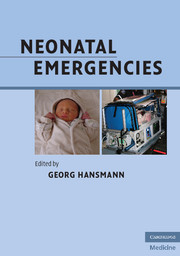Book contents
- Frontmatter
- Contents
- List of contributors
- Foreword (1)
- Foreword (2)
- Preface
- Acknowledgments
- Section 1 Organization of neonatal transport
- Section 2 Basics in cardiopulmonary resuscitation of newborn infants
- Basic equipment setup for initial neonatal care and resuscitation
- Drugs for neonatal emergencies
- Postnatal cardiopulmonary adaptation
- ABC Techniques and Procedures
- Sunctioning
- Stimulation, oxygen supplementation, bag-and-mask ventilation (M-PPV), pharyngeal/bi-nasal CPAP, and pharyngeal positive pressure ventilation
- Endotracheal intubation and gastric tube placement
- Laryngeal mask airway (LMA)
- Chest compressions
- Peripheral venous access
- Umbilical vein/artery catheterization (UVC, UAC)
- Central venous access (internal jugular vein)
- Intraosseous access
- Cord clamping
- Management of high-risk infants in the delivery room
- Monitoring in the delivery room and during neonatal transport
- Hygiene in the delivery room and during neonatal transport (infection control)
- When to call a pediatrician to the delivery room
- Checklist for the postnatal treatment of newborn infants
- Assigning individual duties in the delivery room
- Clinical assessment of the newborn infant
- Cardiopulmonary resuscitation of newborn infants at birth
- Volume therapy and sodium bicarbonate supplementation in preterm and term newborn infants
- Absolute and relative indications for neonatal transport and NICU admission
- Communication with mother and father
- Coordinating neonatal transport and patient sign-out to the NICU team
- Documentation and feedback after neonatal emergency transport
- Ethics in neonatal intensive care
- Perinatal images of preterm and term infants
- Mechanical ventilation of the neonate
- Questions for review (basics)
- References (Section 2)
- Section 3 Classic and rare scenarios in the neonatal period
- Section 4 Transport
- Section 5 Appendix
- Index
- Plate section
Volume therapy and sodium bicarbonate supplementation in preterm and term newborn infants
from Section 2 - Basics in cardiopulmonary resuscitation of newborn infants
Published online by Cambridge University Press: 05 March 2012
- Frontmatter
- Contents
- List of contributors
- Foreword (1)
- Foreword (2)
- Preface
- Acknowledgments
- Section 1 Organization of neonatal transport
- Section 2 Basics in cardiopulmonary resuscitation of newborn infants
- Basic equipment setup for initial neonatal care and resuscitation
- Drugs for neonatal emergencies
- Postnatal cardiopulmonary adaptation
- ABC Techniques and Procedures
- Sunctioning
- Stimulation, oxygen supplementation, bag-and-mask ventilation (M-PPV), pharyngeal/bi-nasal CPAP, and pharyngeal positive pressure ventilation
- Endotracheal intubation and gastric tube placement
- Laryngeal mask airway (LMA)
- Chest compressions
- Peripheral venous access
- Umbilical vein/artery catheterization (UVC, UAC)
- Central venous access (internal jugular vein)
- Intraosseous access
- Cord clamping
- Management of high-risk infants in the delivery room
- Monitoring in the delivery room and during neonatal transport
- Hygiene in the delivery room and during neonatal transport (infection control)
- When to call a pediatrician to the delivery room
- Checklist for the postnatal treatment of newborn infants
- Assigning individual duties in the delivery room
- Clinical assessment of the newborn infant
- Cardiopulmonary resuscitation of newborn infants at birth
- Volume therapy and sodium bicarbonate supplementation in preterm and term newborn infants
- Absolute and relative indications for neonatal transport and NICU admission
- Communication with mother and father
- Coordinating neonatal transport and patient sign-out to the NICU team
- Documentation and feedback after neonatal emergency transport
- Ethics in neonatal intensive care
- Perinatal images of preterm and term infants
- Mechanical ventilation of the neonate
- Questions for review (basics)
- References (Section 2)
- Section 3 Classic and rare scenarios in the neonatal period
- Section 4 Transport
- Section 5 Appendix
- Index
- Plate section
Summary
There is hardly any other topic in the field of neonatal intensive care that bears such controversy.
When (indication)? How much fluid (5, 10, 20 ml/kg IV)? Crystalloid or colloid solutions? How fast (bolus, in 10, 30, 60, 120 min?)
When (indication)? How much sodium bicarbonate? How fast (bolus, in 10, 30, 60, 120 min)?
Pathophysiology
Cardiac output principally is determined by all four of the following components: heart rate (main regulator in neonates), stroke volume, preload (≈ end-diastolic volume of the ventricle; or simplified as ≈ intravascular volume) and afterload (≈ combination of elastance of the great vessels, resistance of the small vessels, and ventricular wall stress).
In neonates, a low heart rate (HR <100 bpm) usually indicates respiratory failure and/or hemodynamic compromise. After birth, pulmonary vascular resistance (PVR) remains high whereas systemic arterial resistance (SVR) is low but starts rising when the umbilical cord is clamped.
The blood volume of a term neonate ranges between 80 and 85 ml/kg, in preterm infants between 90 and 100 ml/kg. Thus, administration of 50 ml volume IV given to a term newborn infant (body weight ≈ 3 kg) is equivalent to one-fifth of the intravascular volume (relative amount even higher in significant hypovolemia)! This will have notable impact on the hematocrit and hemoglobin value due to dilution effects (normal: 45%–60% and 14–20 g/dl, respectively). Oxygen delivery to the peripheral tissue and vital organs (brain, heart, kidneys) depends on perfusion pressure, total intravascular hemoglobin, and oxygenation (FiO2, lung function).
- Type
- Chapter
- Information
- Neonatal Emergencies , pp. 173 - 178Publisher: Cambridge University PressPrint publication year: 2009



